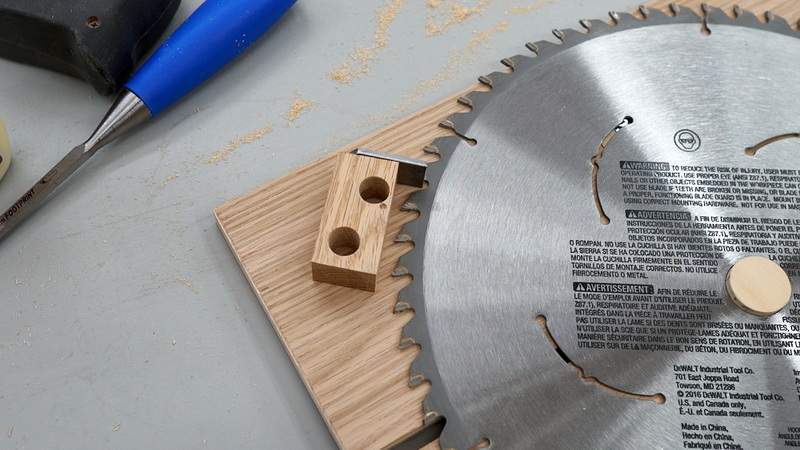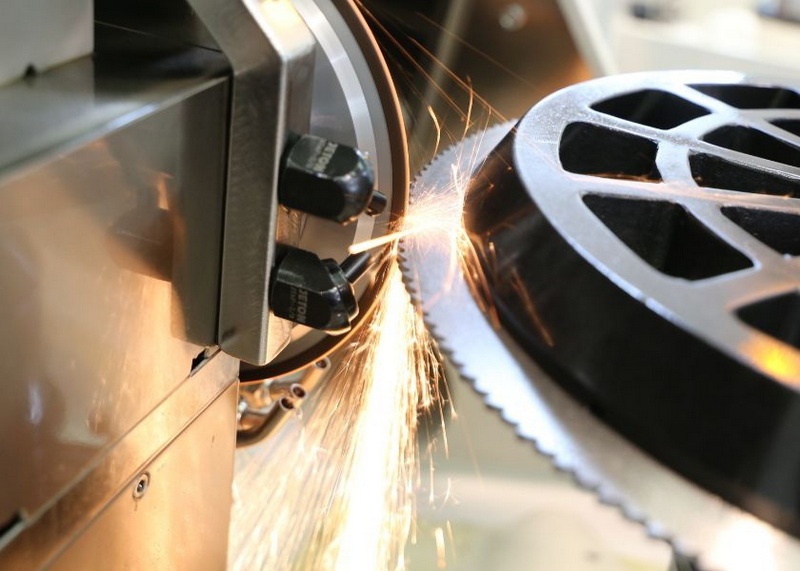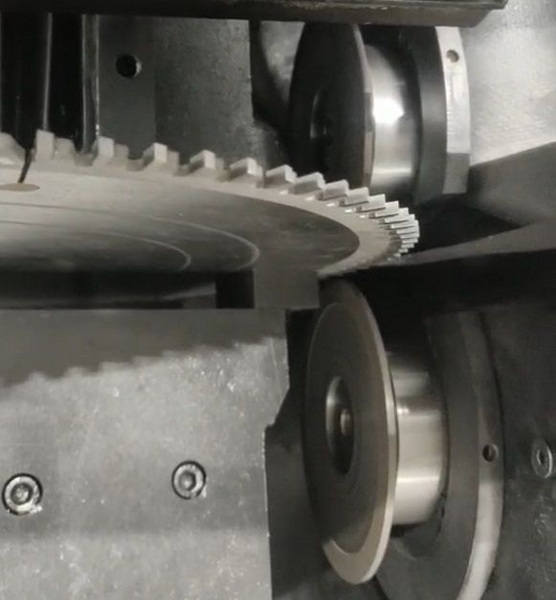Content Menu
● Introduction to Tungsten Carbide
● Methods for Sharpening Tungsten Carbide Blades
>> 1. Diamond Grinding Wheels
>> 2. Silicon Carbide Grinding Wheels
>> 3. Electrical Discharge Machining (EDM)
>> 4. Laser Sharpening
● Factors to Consider When Sharpening Tungsten Carbide Blades
● Common Mistakes to Avoid
● Maintenance and Cleaning of Tungsten Carbide Blades
● Advanced Techniques for Specific Applications
● Conclusion
● FAQs
>> 1. What is the best method for sharpening tungsten carbide blades?
>> 2. Can tungsten carbide blades be sharpened at home?
>> 3. How often should tungsten carbide blades be sharpened?
>> 4. What are the risks of overheating during sharpening?
>> 5. Can silicon carbide wheels be used for sharpening tungsten carbide blades?
● Citations:
Tungsten carbide saw blades are renowned for their durability and hardness, making them indispensable in various industries that require precision cutting. However, like all blades, they eventually dull and need sharpening to maintain optimal performance. Sharpening tungsten carbide blades requires specialized techniques and equipment due to their exceptional hardness. In this article, we will explore the best methods for sharpening tungsten carbide saw blades, including diamond grinding wheels, silicon carbide wheels, EDM, and laser sharpening.

Introduction to Tungsten Carbide
Tungsten carbide is a composite material made from tungsten and carbon, known for its superior hardness and wear resistance. These properties allow tools made from tungsten carbide to maintain their sharpness and structural integrity for longer periods, reducing the need for frequent replacements. Tungsten carbide saw blades are particularly valued in woodworking and metal cutting industries due to their ability to withstand high temperatures and maintain cutting efficiency over time.
Methods for Sharpening Tungsten Carbide Blades
1. Diamond Grinding Wheels
Diamond grinding wheels are the most effective method for sharpening tungsten carbide blades. Since diamond is one of the few materials harder than tungsten carbide, it can precisely grind and restore the blade's edge with minimal wear to the grinding tool.
Benefits:
- High Precision: Diamond grinding wheels provide excellent control, maintaining the sharpness and angle of the blade's cutting edge.
- Long-lasting: Diamond grinding wheels are extremely durable and can be used repeatedly without noticeable wear.
- Fast Process: Sharpening tungsten carbide blades with diamond grinding wheels is efficient and effective, restoring sharpness quickly.
How to Use:
1. Set the blade at the correct angle against the grinding wheel.
2. Use a coolant to prevent overheating, which can damage the tungsten carbide.
3. Apply consistent pressure to obtain a sharp, even edge.
Diamond grinding wheels are typically mounted on a grinder and used in a controlled environment to ensure precision and safety.
2. Silicon Carbide Grinding Wheels
Silicon carbide grinding wheels are a lower-cost alternative to diamond wheels, although they are less effective for regular, heavy-duty sharpening of tungsten carbide. Silicon carbide is still hard enough to grind carbide blades, but it may take longer and result in more wear on the grinding wheel.
Benefits:
- Affordable: Silicon carbide wheels are more cost-effective than diamond wheels.
- Accessible: They are widely available and can be used for lighter or occasional sharpening needs.
How to Use:
1. Position the blade correctly.
2. Apply consistent pressure.
3. Ensure the blade remains cool during the grinding process.
Silicon carbide wheels are often used in smaller workshops or for less demanding applications.
3. Electrical Discharge Machining (EDM)
EDM is an advanced technique for sharpening tungsten carbide blades that uses electrical discharges to erode material from the blade's surface. This method is known for its precision and ability to sharpen intricate and complex blade designs without applying mechanical force.
Benefits:
- High Precision: EDM is capable of extremely fine sharpening, making it ideal for blades that require intricate geometries or tight tolerances.
- No Mechanical Stress: Unlike grinding, EDM does not apply physical force to the blade, reducing the risk of deformation or damage.
How to Use:
1. Place the blade in an EDM machine.
2. Use electrical discharges to precisely erode material from the blade's edge.
EDM machines are highly specialized and require technical expertise to operate.
4. Laser Sharpening
Laser sharpening is a modern method that uses focused laser beams to sharpen tungsten carbide blades. This process is highly accurate and non-contact, meaning the laser does not physically touch the blade, eliminating the risk of mechanical wear.
Benefits:
- Extreme Precision: Laser sharpening can restore blades to their original sharpness with a high level of accuracy, even for blades with complex edges.
- No Physical Wear: Because there is no contact between the laser and the blade, there is no risk of physical wear or damage.
- Quick Process: Laser sharpening can be faster than traditional grinding methods, making it suitable for high-production environments.
How to Use:
1. Direct a concentrated laser beam at the blade's cutting edge.
2. Vaporize small amounts of material to restore sharpness without applying any physical force.
Laser sharpening requires advanced machinery and is typically performed in industrial settings.

Factors to Consider When Sharpening Tungsten Carbide Blades
When sharpening tungsten carbide blades, several factors are crucial to ensure the best results:
- Cooling: Overheating is one of the biggest risks when sharpening tungsten carbide. Using a coolant is essential to keep the blade at a safe temperature and prevent microcracks that could compromise its durability.
- Proper Angle: Maintaining the correct sharpening angle is crucial for achieving a sharp edge while preserving the blade's original geometry. Using a guide can help ensure precision.
- Sharpening Frequency: Regular maintenance is key. Don't wait until the blade becomes completely dull before sharpening, as this can reduce efficiency and lead to more frequent replacements.
- Quality of Sharpening Tools: High-quality diamond or silicon carbide grinding wheels are necessary for sharpening tungsten carbide blades effectively. Using the wrong abrasive can lead to poor results and potentially damage the blade.
Common Mistakes to Avoid
Sharpening tungsten carbide blades requires a careful approach. Here are some common mistakes to avoid:
- Overheating the Blade: Excessive heat can cause microfractures or even break the tungsten carbide. Always use coolant when sharpening to keep the blade cool.
- Using Inappropriate Abrasives: Only materials harder than tungsten carbide, such as diamond or silicon carbide, should be used for sharpening. Using softer abrasives will not sharpen the blade effectively.
- Incorrect Sharpening Angle: Applying the wrong angle can result in uneven wear and poor cutting performance. Use a sharpening guide to maintain consistency.
- Neglecting Regular Maintenance: Waiting too long to sharpen a blade can result in a longer sharpening process and decreased efficiency. Regular sharpening keeps your blades in optimal condition.
Maintenance and Cleaning of Tungsten Carbide Blades
In addition to sharpening, regular cleaning and maintenance are essential for extending the lifespan of tungsten carbide blades. Here are some tips:
- Cleaning: Use a soft brush or compressed air to remove debris and resin buildup from the blade. This helps maintain the blade's cutting efficiency and prevents damage from accumulated debris[2][7].
- Lubrication: Apply special coolants to reduce friction and heat during cutting operations. This helps extend the lifespan of the blade by preventing overheating and wear[2][7].
- Storage: Store blades in a dry, safe place to prevent corrosion and physical damage.
Advanced Techniques for Specific Applications
For specialized applications, such as woodworking or metal cutting, different techniques may be required:
- Woodworking: Tungsten carbide saw tips are ideal for woodworking due to their durability and ability to withstand resin buildup. Regular cleaning and sharpening are crucial to maintain efficiency[8].
- Metal Cutting: In metal cutting, maintaining precise angles and using high-quality sharpening tools is essential to prevent blade wear and ensure clean cuts[7].
Conclusion
Sharpening tungsten carbide saw blades is a critical task for maintaining their performance and extending their lifespan. By using the right techniques and equipment, such as diamond grinding wheels, silicon carbide wheels, EDM, and laser sharpening, you can ensure that your blades remain sharp and efficient over time. Regular maintenance and proper sharpening practices are essential for achieving optimal results.

FAQs
1. What is the best method for sharpening tungsten carbide blades?
The best method for sharpening tungsten carbide blades is using diamond grinding wheels due to their precision and durability[1][3].
2. Can tungsten carbide blades be sharpened at home?
While it is technically possible to attempt sharpening tungsten carbide blades at home, it is generally recommended to have them sharpened by professionals with the right equipment and expertise to avoid damaging the blades[3].
3. How often should tungsten carbide blades be sharpened?
Tungsten carbide blades should be sharpened regularly before they become completely dull. This helps maintain efficiency and extends the blade's lifespan[1].
4. What are the risks of overheating during sharpening?
Overheating can cause microfractures or even break the tungsten carbide. Using a coolant is essential to prevent this[1][4].
5. Can silicon carbide wheels be used for sharpening tungsten carbide blades?
Yes, silicon carbide wheels can be used, but they are less effective than diamond wheels and may wear down faster[1].
Citations:
[1] https://passionblade.com/what-is-the-best-way-to-sharpen-tungsten-carbide-blade/
[2] https://www.cycarbide.com/products/tungsten-sawing-tips/
[3] https://www.linkedin.com/pulse/how-sharpen-tungsten-carbide-shijin-lei
[4] https://www.eyan.com/en-US/newsc43-how-to-sharpen-a-circular-saw-blade
[5] https://www.konetool.com/how-to-clean-the-tungsten-blade/
[6] https://www.empireabrasives.com/blog/guide-troubleshooting-tungsten-carbide-burrs-issues-solutions/
[7] https://www.tungstencarbideman.com/productinfo/1389893.html
[8] https://www.tungstenman.com/carbide-tip-hole-saws.html
[9] https://www.4x4community.co.za/forum/showthread.php/335502-Sharpening-a-tungsten-tipped-saw-blade
[10] https://www.bladeforums.com/threads/tungsten-carbide-sharpening.1867146/
[11] https://knife.wickededgeusa.com/forums/topic/any-tips-on-sharpening-a-sandrin-tungsten-carbide-blade/
[12] https://carbideprocessors.com/pages/carbide-parts/carbide-defects.html
[13] https://www.youtube.com/watch?v=ikCBVvZ7ZcA
[14] https://carbideprovider.com/tungsten-carbide-saw-tips-20231220/
[15] https://www.reddit.com/r/chefknives/comments/9kxss2/tungsten_carbide_sharpeners/
[16] https://turnedwoodenbowls.co.uk/2019/12/17/sharpening-band-saw-blades/
[17] https://www.linkedin.com/pulse/how-maintenance-tungsten-carbide-saw-blade-phoebe-lueng
[18] https://int-enviroguard.com/blog/tungsten-carbide-exposure-are-your-workers-at-risk/
[19] https://www.eyan.com
[20] https://www.ukocarbide.com/blog/sharpening-and-maintaining-circular-saw-blades-correctly/
















